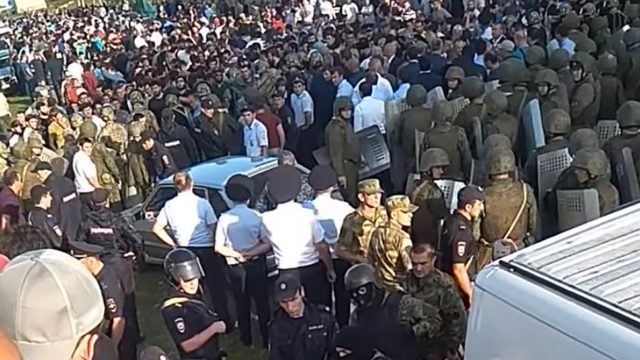
Some Turkic Balkars Want Their Own Republic in the North Caucasus
Publication: Eurasia Daily Monitor Volume: 17 Issue: 24
By:

A group of people unexpectedly disrupted a large assembly of Balkar activists in Nalchik, the capital of the Northwest Caucasus republic of Kabardino-Balkaria. On February 2, dozens of youths stormed a hall where the congress of the Council of Elders of the Balkar People (CEBP) was being held. The incursion made it impossible to continue the meeting, stated the head of the organization, Ismail Sabanchiev. According to Sabanchiev, the demonstrators accused him of not doing enough to support the secession of the Balkar people from Kabardino-Balkaria to form their own republic. The activist called the disrupters “extremists” and expressed his determination to hold the congress of Balkar people at a later time. According to one of the delegates of the Balkars, Zoya Alikaeva, “The CEBP is the only organization that protects the interests of the Balkar people. There are other public organizations as well, but it is unknown what they are doing. Nobody attacks them because they do not do anything” (Kavkazsky Uzel, February 4).
Kabardino-Balkaria is a multiethnic republic with a total population of about 900,000 (2010 Russian census). Ethnic Kabardins (Circassians) make up about 57 percent of the republican population, ethnic Russians rank second with about 23 percent, and Turkic-speaking Balkars come third, with less than 13 percent or nearly 110,000 people. Balkars suffered deportation under Joseph Stalin’s rule, along with their co-ethnic Karachays in the neighboring Karachaevo-Cherkessia. They were accused of collaborating with Nazi Germany and sent en masse to the remote areas of modern-day Kazakhstan and Kyrgyzstan. In 1956, during the political thaw following Stalin’s death, Balkars were allowed to return to their homeland in the Caucasus. In recent decades, Balkar activists have often claimed that they are discriminated against by the Circassian-dominated government of Kabardino-Balkaria. As such, radical Balkar activists long sought to secede from the republic to establish their own administrative entity within the Russian Federation. Others offered a lighter version of secession—the formation of administratively separate Balkaria and Kabarda regions within Kabardino-Balkaria, so that Balkars could have a greater say in their own sub-region (EurAsia Daily, January 20, 2017).
Balkars have traditionally lived in the mountainous area of the republic, which also happens to be an important source of revenue from tourism. Mount Elbrus, the highest peak in Russia and the European continent, is located in the border area between Kabardino-Balkaria and Karachaevo-Cherkessia. Balkars and Kabardins frequently accuse each other of land grabs of their respective traditional lands (E-notabene.ru, September 27, 2018).
Balkars have not staged large-scale public protests in Kabardino-Balkaria for a long time, but their activists speak out regularly. For example, in March of last year, at the public gathering commemorating 75 years since the Stalinist deportation of the Balkar people, some speakers “incited inter-ethnic strife,” according to the assessment of a Circassian group. Reportedly, one of the former Balkar officials, during a conflict in the village of Kendelen, even sent a telegram to President Vladimir Putin, claiming that a “genocide of the Balkar people” was taking place in Kabardino-Balkaria and called for the Kremlin leader to intervene (Caucasus Times, October 21, 2019).
In September 2018, the Balkar-populated settlement of Kendelen saw the worst clashes ever between the local police and Circassian activists. The Circassians, led by the well-known horse breeder and activist Ibragim Yaganov, wanted to hold a commemorative horseback-riding tour to mark 310 years since the Kanjal battle. Many historical accounts assert that the Circassian army dealt a crushing defeat to Crimean Khan Kaplan I Giray’s troops during this encounter (Topwar.ru, February 6, 2020). Turkic-speaking Balkars did not approve of the Circassian commemoration, however, and tensions between the two sides quickly spiraled out of control. The police sided with the Balkars and drove back the Circassian activists. Some of them were subsequently detained (Kommersant, September 19, 2018).
The then-governor of Kabardino-Balkaria, Yuri Kokov, did not survive the clashes politically. Within days of the uprising, he stepped down and was appointed the deputy head of the Russian Security Council. Kokov had previously held several top positions in the Russian Ministry of Interior. He was succeeded by Kazbek Kokov, who is the son of the first president of Kabardino-Balkaria, Valery Kokov (Kommersant, September 26, 2018).
Even as governors of the republic keep changing, the Balkars continue to face obstacles in convincing the authorities of their grievances. And while it is unlikely that, in the current political environment in Russia, Balkar activists will achieve their goals of greater autonomy, recent events indicate that inter-ethnic relations in Kabardino-Balkaria remain quite explosive. The events in the village of Kendelen, in particular, showed that the Balkars need not even play a serious role in the riots. Indeed, the Circassians primarily clashed with the police, not with the Balkars. The main issue in the republic appears to be motivated by politics and the economy rather than ethnic strife per se. However, the latter surfaces because regular channels of political communication and popular deliberation are blocked under Russia’s system of “sovereign democracy” and the “power vertical.” This means that more ethnic-based conflicts are likely to follow unless the political (and economic) system in Kabardino-Balkaria becomes more open and participatory.



